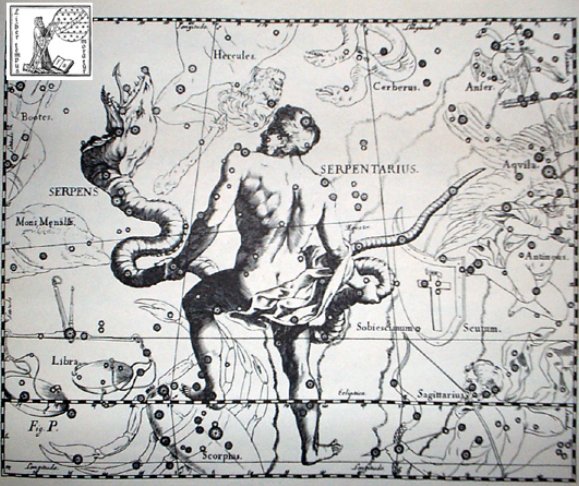9. However, after all these exercises I feel we should abandon the idea that the nakshatra parallel stars and dates can explain the contrary sense in the K text. Undeniably are the basic star positions also in K defined by heliacal risings, for instance are the glyphs at π and ο Virginis parallel with those in G (see at Conclusions). Therefore not only Ain (ε) but also the twin stars θ Tauri could be illustrated in Ka1-1--2:
Yet, those glyphs which do not refer directly to heliacal stars - if there are such glyphs - are free to use for other purposes and quite possibly for nakshatra allusions. The beginning of the K text could allude to the heads of Ophiuchus and Hercules:  Although time moves from left to right in the pictures of Hevelius and the upside down head (È) of Hercules, face to face with the head (Ç) of Ophiuchus, comes earlier, the basic movement in time is here upwards and then Hercules will come later. Moreover, the Club of Hercules (Caiam) comes earlier than the head of Ophiuchus. From Kajam (ω Herculis) to Cujam (ε Herculis) the path of time goes obliquely upwards to the right, while Ophiuchus is climbing up into the past at left. Possibly the 24th Greek letter o-mega, the great o, was given the sign ω as a symbol meaning 2 upside down heads (twins). Reordered they could form the 8th letter θ, with only the bottom head upside down. Thus I would like to summarize so far:
Then follows a section with 2 + 2 = 4 glyphs and 4 + 1 = 5 not used glyph spaces:
I think we should count also the vacant glyph places, because the total will then rise from 181 to 192, a number we know is important (e.g. because it is equal to 8 * 24):
It could be a hint for the reader that the visible glyphs represent the days according to a solar calendar. But my 'planetary colours' will fit better if we count also the not visible glyphs. Atariki (the Shadow King) in *Ka1-18 ought to be black. The first 5 (counting also 'May 31) days of 'June are in place, but then - at right ascension '5h - the visibility suddenly drops. In the following week only 2 days are visible. The pair of glyphs at λ Eridani and Rigel are painted green (Venus) respectively black (Saturn) by me. Cursa (β Eridani, close to β Orionis, Rigel) is painted red, and possibly it is an empty 'chair' (cursa) which is visualized in Ka1-12. ... Cursa, 3º to the northwest of Rigel in Orion, is the principal star in the constellation, seen from the latitude of New York City. The word is from Al Kursiyy al Jauzah, the Chair, or Footstool, of the Central One, i.e. Orion, formed by β, λ, and ψ Eridani ... and regarded as the support of his left foot; but in the earlier astronomy of the nomads it was one of Al Udhā al Na'ām, the Ostrich's Nest, that some extended to ο¹ and ο². The Century Encyclopedia gives Dhalim as an alternative title, undoubtedly from Al Thalīm, the Ostrich; but although used for it by several writers, this better belongs to θ ..
The voyage goes up from the deeps of Eridanus. Yed Prior and Yed Posterior (δ respectively ε Ophiuchi), which are at the beginning of constellation and at the end of the K text, also seem to be associated with movement up (growth):
Manzil day 192 could be alluded to in Ka1-1.
But the twice 3 dark 'nuts' in Ga7-15 are rising in front in 'November 24 (and not in 'November 22-23).
| |||||||||||||||||||||||||||||||||||||||||||||||||||||||||||||||||||||||||||||||||||||||||||||||||||||||||||||||||||||||||||||||||||||||||||||||||||||||||||||||||||||||||||||||||||||||||||||||||||||||||||||||||||||||||||












